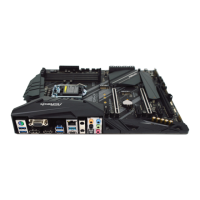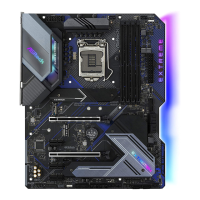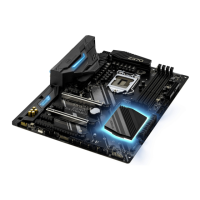Do you have a question about the ASROCK Z87M Extreme4 and is the answer not in the manual?
Lists items included in the motherboard package.
Details the technical specifications of the motherboard.
Highlights special features and technologies of the motherboard.
Illustrates and labels components on the motherboard.
Describes the input/output ports on the motherboard's rear panel.
Step-by-step guide for installing the CPU onto the motherboard socket.
Instructions for mounting the CPU cooler and fan.
Guide for inserting RAM modules into the motherboard slots.
Explains the PCI and PCIe slots and their configurations.
Details the function and setup of motherboard jumpers.
Identifies and explains onboard headers and connectors for system assembly.
Guide for setting up NVIDIA SLI configurations.
Instructions for installing two NVIDIA SLI-ready graphics cards.
Steps to install drivers for SLI configurations.
Guide for setting up AMD CrossFire configurations.
Instructions for installing two AMD CrossFireX-ready graphics cards.
Instructions for installing three AMD CrossFireX-ready graphics cards.
Steps to install drivers for CrossFire configurations.
Guide to installing essential motherboard drivers from the support CD.
Overview and usage of ASRock's multi-purpose tuning utility.
Setup and usage for faster system wake-up from deep sleep.
Configuration for automatic email/social network updates during sleep.
Guides for remotely waking up the PC using MeshCentral or Splashtop.
Information on using Intel's utility for system tuning and overclocking.
Instructions for installing and configuring the Start8 utility for Windows 8.
General introduction to the UEFI BIOS setup utility.
Explains the main menu bar options in the UEFI setup.
Details the keyboard keys used for navigating the UEFI utility.
Description of the main screen and system overview.
Explains settings related to CPU and GPU overclocking.
Overview of the advanced settings section in UEFI.
Settings for CPU features, power management, and performance.
Settings related to the motherboard chipset and PCIe lanes.
Settings for SATA controllers, modes, and RAID.
Configuration of Intel Rapid Start within UEFI.
Configuration of Intel Smart Connect within UEFI.
Settings for serial ports, infrared ports, and other Super IO features.
Settings for power management and wake-up events.
Settings for enabling/disabling USB controllers and legacy support.
Settings for BIOS support of security devices.
Description of utilities available in the UEFI Tools menu.
Monitoring system hardware status like temperature, fan speed, and voltage.
Configuring system boot options and device priority.
Setting supervisor/user passwords and secure boot.
Options for saving changes, discarding, and loading defaults in UEFI.
Lists items included in the motherboard package.
Details the technical specifications of the motherboard.
Highlights special features and technologies of the motherboard.
Illustrates and labels components on the motherboard.
Describes the input/output ports on the motherboard's rear panel.
Step-by-step guide for installing the CPU onto the motherboard socket.
Instructions for mounting the CPU cooler and fan.
Guide for inserting RAM modules into the motherboard slots.
Explains the PCI and PCIe slots and their configurations.
Details the function and setup of motherboard jumpers.
Identifies and explains onboard headers and connectors for system assembly.
Guide for setting up NVIDIA SLI configurations.
Instructions for installing two NVIDIA SLI-ready graphics cards.
Steps to install drivers for SLI configurations.
Guide for setting up AMD CrossFire configurations.
Instructions for installing two AMD CrossFireX-ready graphics cards.
Instructions for installing three AMD CrossFireX-ready graphics cards.
Steps to install drivers for CrossFire configurations.
Guide to installing essential motherboard drivers from the support CD.
Overview and usage of ASRock's multi-purpose tuning utility.
Setup and usage for faster system wake-up from deep sleep.
Configuration for automatic email/social network updates during sleep.
Guides for remotely waking up the PC using MeshCentral or Splashtop.
Information on using Intel's utility for system tuning and overclocking.
Instructions for installing and configuring the Start8 utility for Windows 8.
General introduction to the UEFI BIOS setup utility.
Explains the main menu bar options in the UEFI setup.
Details the keyboard keys used for navigating the UEFI utility.
Description of the main screen and system overview.
Explains settings related to CPU and GPU overclocking.
Overview of the advanced settings section in UEFI.
Settings for CPU features, power management, and performance.
Settings related to the motherboard chipset and PCIe lanes.
Settings for SATA controllers, modes, and RAID.
Configuration of Intel Rapid Start within UEFI.
Configuration of Intel Smart Connect within UEFI.
Settings for serial ports, infrared ports, and other Super IO features.
Settings for power management and wake-up events.
Settings for enabling/disabling USB controllers and legacy support.
Settings for BIOS support of security devices.
Description of utilities available in the UEFI Tools menu.
Monitoring system hardware status like temperature, fan speed, and voltage.
Configuring system boot options and device priority.
Setting supervisor/user passwords and secure boot.
Options for saving changes, discarding, and loading defaults in UEFI.
| ECC | No |
|---|---|
| Non-ECC | Yes |
| Memory channels | Dual-channel |
| Memory slots type | DIMM |
| Number of memory slots | 4 |
| Supported memory types | DDR3-SDRAM |
| Maximum internal memory | 32 GB |
| Supported memory clock speeds | 1066, 1200, 1300, 1333, 1500, 1600, 1666, 1800, 1866, 1900, 2000, 2100, 2133, 2200, 2250, 2400, 2450, 2600, 2666, 2800 MHz |
| Processor socket | LGA 1150 (Socket H3) |
| Processor manufacturer | Intel |
| Compatible processor series | Intel Celeron, Intel Pentium |
| Maximum number of SMP processors | 1 |
| USB 2.0 connectors | 2 |
| Number of SATA III connectors | 6 |
| Number of Parallel ATA connectors | 0 |
| Headphone outputs | 5 |
| USB 2.0 ports quantity | USB 2.0 ports have a data transmission speed of 480 Mbps, and are backwards compatible with USB 1.1 ports. You can connect all kinds of peripheral devices to them. |
| Audio chip | Realtek ALC1150 |
| Cooling type | Passive |
| Certification | FCC, CE, WHQL, ErP/EuP |
| Component for | PC |
| Power source type | ATX |
| Motherboard chipset | Intel® Z87 |
| PC health monitoring | CPU, FAN, Temperature |
| Audio output channels | 7.1 channels |
| Motherboard form factor | micro ATX |
| RAID levels | 0, 1, 5, 10 |
| Supported storage drive interfaces | SATA, SATA II, SATA III |
| Graphics card | HD Graphics |
| Maximum resolution | 4096 x 2304 pixels |
| Maximum graphics card memory | 1792 MB |
| Parallel processing technology support | 2-Way CrossFireX, 2-Way SLI, 3-Way CrossFireX, Quad-GPU CrossFireX, Quad-GPU SLI |
| PCI Express slots version | 2.0, 3.0 |
| PCI Express configurations | 1x4, 1x16, 2x8 |
| Cables included | SATA |
| Ethernet interface type | Gigabit Ethernet |
| BIOS type | EFI AMI |
| ACPI version | 1.1 |
| BIOS memory size | 64 Mbit |
| Width | - mm |
|---|











